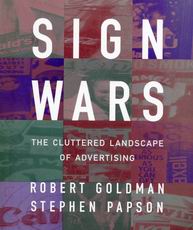
| Home News Releases | Calendar Contact |
Sources Bookshelf

Sign Wars
The Cluttered Landscape of Advertising
Goldman, Robert; Papson, Stephen
Publisher: The Guilford Press, New York, USAYear Published: 1995
Pages: 322pp ISBN: 1-57230-034-5
Library of Congress Number: HF5821.G583 1995 Dewey: 659.1'042-dc
Please see our media profile in Sources:
Sources Select Resources
A war of competing images and slogans has been waged by the advertising industry in an attempt to engage the ever-diminishing attention span of the North American consumer. Sign Wars, written by Robert Goldman and Stephen Papson, deconstructs the strategies used to distinguish one brand name from another by the use of commodity signs. Examining network television ads from the mid 1980's to early 1990's, Goldman and Papson investigate the advertisers' search for the untouched and compelling image to compel the viewer, and the effect of such cultural clear-cutting on the value of any sign.
"As with any war, there is not only something to be won here, but also much to be lost. When advertisers tap into, extract, and appropriate new cultural styles and images for the purpose of placing them in association with their commodities, they also risk a haemorrhaging of meaning. Paradoxically, the more intensely advertisers compete for the most valuable signs, the faster their signs cease to sizzle." p. vi
Sign Wars becomes a bit convoluted when initially communicating the theories; it's real strength is in the deconstruction of the ads themselves. Unfortunately, the illustrations provided are limited to small black-and-white stills which do not always demonstrate that which is being analysed. This insightful and exhaustive analysis of our "cluttered landscape" of commodity signs focuses on the beer, sneaker, credit card and soft drink image wars. When the products themselves are indistinguishable, brand name recognition and loyalty have created a billion-dollar industry of intangible assets. But consumers are not simply fickle, they are becoming more media literate. As the sign wars escalate, viewers resent feeling manipulated. The struggle to capture but not alienate the viewer has led the advertising industry to abandon the Technicolour musicals and saccharine depictions of white-bread culture of the 1980s. Goldman and Papson trace the introduction of advertising "realism", such as the hand-held camera and jump cuts, as an initial attempt to play on the viewer's search for authenticity.
Exploring the contemporary landscape of signs and images, Goldman and Papson identify three modes of communication. Ads such as the Energizer bunny banging its way through inane commercials for bogus products affirm the alienated state of the spectators who feel manipulated into parting with their money. By contrast, the Saturn campaign uses home movies, Pat Boone songs and sepia toned footage to invoke nostalgia for a simpler time, when one wasn't bombarded with advertisements. Saturn's commitment to personalised service and company loyalty, including the infamous Saturn owners picnic in Spring Hill, population 1200, responds to the consumer's yearning for a commodity community. Finally, in one of the more illuminating chapters, Sign Wars examines "Authenticity in the Age of the Poseur", which seeks to explain why your favourite indie band just showed up in an ad for The Gap.
Sign Wars also includes a chapter on green eco-marketing and the exploitation of the spectacle of nature. An analysis of the Downy refill reveals a societal acceptance of recycling as a viable method to save the planet, and the use of children as a signifier of environmental wellness. A chapter on corporate promotional videos reveals a similar agenda to manipulate the public trust. Following Three Mile Island and Chernobyl, the U.S. Committee for Energy Awareness, ran a series of TV ads featuring the "Nuclear Mom". She states, "When I was in college, I was against nuclear energy, but I've reached a different conclusion. It means cleaner air for the planet."
While the motive behind every advertisement is obviously money and power, Goldman and Papson's focus is sociological, therefore they tend to highlight the methods of mirroring and challenging the culture of the viewer rather than the needs and motives of a commodity-based economy. Although they do comment on the disintegration of history as a compelling narrative, and the celebration of superficial appearances over the scared and meaningful, Sign Wars is primarily a deconstruction of a series of advertisements. This can become repetitive, and one longs for an analysis of the "why" along with the "how". Nonetheless, Papson and Goldman's sweeping research makes for compelling reading, and would be of tremendous use to those investigating advertising in the world of contemporary media.
[Reviewed by Kate Miles]
Subject Headings
© Sources 2023. The information provided is copyright and may not be reproduced in any form or by any means (whether electronic, mechanical or photographic), or stored in an electronic retrieval system, without written permission of the publisher.